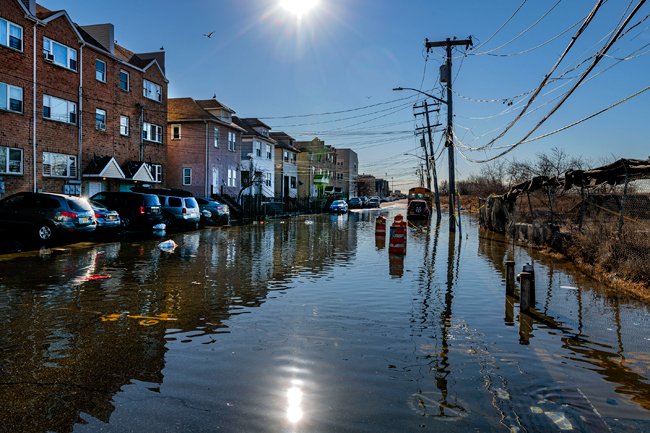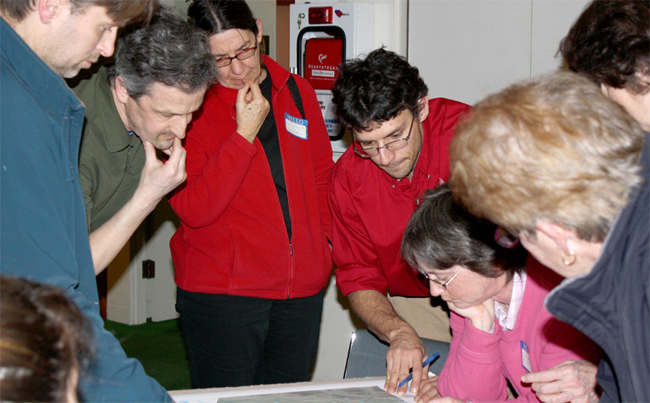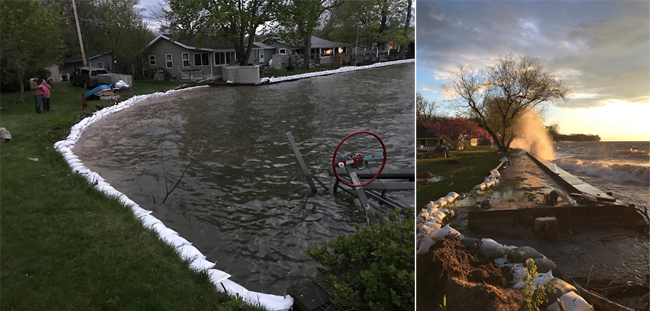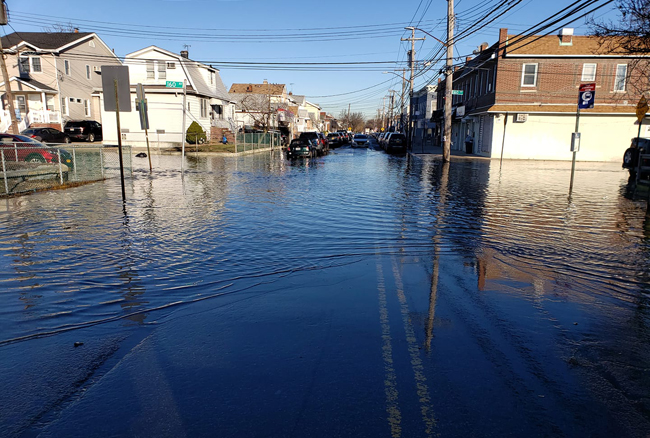
An inundated street lies between a city block and the shore in Far Rockaway, Queens. This photo was also taken on January 4, 2022 during a “sunny day” high tide flood event. Credit: Giles Ashford, NYC Community Flood Watch Project.
Organizers say the needs and opportunities for this program are great; one of only two like it in the country
— By Chris Gonzales, Freelance Science Writer, New York Sea Grant
Contact:
Katherine Bunting-Howarth, NYSG’s Associate Director, E: keb264@cornell.edu, P (607) 255-2832
Ithaca, NY, March 10, 2022 — The facts are clear: The Earth is warming and New York is seeing the effects, from rising temperatures, elevated sea levels, to more extreme and hazardous weather events. In recent years, precipitation has become less frequent but more intense, meaning very heavy rain events are occurring more often.1 Extreme rainstorms can result in multiple impacts including the temporary closure of roadways, and faster stream flows can erode the bases of bridges, a hidden but serious problem.2
Scientists expect that New York’s climate will continue to change over the coming decades.3 In the face of the challenges posed by climate change, specialists at Cornell University (Cornell) and New York Sea Grant (NYSG) are establishing a program of stewards who are being trained to help their communities mitigate the causes of climate change and adapt to become more resilient. These new Cornell Climate Stewards will be educating community members about what these changes could mean for our livelihoods and businesses.

Cornell Climate Stewards
As of now, the program — developed by Cornell, NYSG, and Cornell Cooperative Extension with a planning grant from the National Institute for Food and Agriculture (NIFA), and pilot funding from Cooperative Extension Smith-Lever federal funds and the New York State Energy Research Development Agency (NYSERDA) — is being piloted in six counties from around New York State: Dutchess, Ulster, Monroe, Seneca, and Tompkins, plus New York City (Kings County).
The objective of the Climate Stewards program is to provide research-based, hands-on training to community members who are motivated to work on climate change at the local level. Participants will be trained to contribute to community resilience by increasing local community capacity to address the myriad of causes and consequences of climate change. After completing the 12-week training program in the fall of 2021, new stewards are committed to contributing 40 hours over the next year, completing a local climate project of their own choosing.
In addition, participants may provide support to municipalities throughout the State as they work toward achieving their greenhouse gas emissions reduction and adaptation goals set out under the Climate Leadership and Community Protection Act (CLCPA).
In return for completing a climate stewards project—for example, by completing an assessment or planning project, writing a grant application, or carrying out a New York State Climate Smart Communities (CSC) certification action—participants will become certified Cornell Climate Stewards.
Other examples of projects are: working on a local climate change task force; supporting the development of a watershed management plan; conducting a riparian buffer project; or working with the local library system or school district on a climate change education program. All of these projects can also help a municipality earn points towards their CSC certification.
“We know that local governments need resources, fiscal and human, in order to take steps towards climate resilience,” said Katherine Bunting-Howarth, NYSG’s associate director. “Climate Stewards are highly-trained individuals with the mission of assisting their local communities to make positive change in the face of climate change.”
Mitigation and adaptation
This program is cultivating a trained team of individuals who are committed to working locally in the community and implementing specific mitigation and adaptation projects. Mitigation strategies would blunt or reduce the impacts of climate change. Adaptation strategies would allow us, as a society, to cope with the changes that scientists expect are coming.
The project development team also collected information about available climate change–related educational programs. They surveyed stakeholders in communities throughout the Northeast region. Through these surveys the team found that the majority of stakeholders believe that “many communities across the [Northeast] region are not well-prepared for the impacts of climate change.” Most communities do not have the capacity to take on mitigation or adaptation projects.
Benefits of Individual and Local Action
The project development team believes that by training individuals in the Northeast in the science of climate change, they can help increase the capacity of local communities to respond through projects to reduce GHG emissions. A wide range of projects could be planned for individuals based on their needs and interests. The hope is that these projects could also be shared, adapted and spread to other communities. There is only one other program like the one being developed in New York, in the state of California, and the need and opportunities are great.
“Climate change is a monumental global challenge that won’t be solved by national governments or the United Nations alone,” said Allison Chatrchyan, senior research associate in the Department of Earth and Atmospheric Sciences at Cornell University. “We are seeing more and more climate actions being taken by states, cities, and even smaller local municipalities, all over the world. But we are going to need climate action at all levels of society, including all types of organizations, businesses, and individuals to ensure that we can meet our goals to hold warming to 2°C, let alone reaching the global goal of 1.5°C.”
When asked why they want to be a Climate Steward, one new trainee said, “I want to work to slow the climate crisis and educate others how they can help slow the climate changes in our area. I have given this program lots of thought and want to share with others any usable ways to approach climate change.”

The Cornell Climate Stewards Program team is developing new resources and tools to train volunteers (such as these folks working with Cornell Cooperative Extension in Dutchess County) who can help their communities make more informed decisions to mitigate greenhouse gases and adapt to New York’s changing climate. Credit: Allison Chatrchyan.
More Info: Participants From Climate Change Program Speak
“What an opportunity for the motivated! World-class Cornell scientists and educators. A collection of well-screened references. Hand-selected co-participants. But you have to work at it or this opportunity is squandered.” —Richard Mattocks (Dutchess County)
“Participating in the first-ever Climate Stewards training will help me work locally for positive change. I’m excited that this program is being offered across New York State!” —Anisa Mendizabal (Seneca County)
“As a newly-fledged Climate Steward, I now pledge to volunteer at least 40 hours to roll out a mini-network of electric vehicle chargers in sync with my rural home Town Board. . . Since each Climate Steward comes up with their own climate resilience project, it ends up being personally exhilarating. And we all have new networks!” —Holly Payne (Tompkins County)
“This program has given me the skill set and desire to seek out people who wish to mitigate and adapt to climate change in their own communities.” —Jack Persely (Dutchess County)
More Info: Scientists Assess Climate Change

(At left) Sandbags can prevent even more catastrophic flooding. This photo was taken on the edge of Lake Ontario, in the Town of Sterling, Cayuga County, in upstate New York; (At right) The waters of Lake Ontario flow over a barrier in the Town of Carlton, Orleans County, in upstate New York. Credit: New York Sea Grant Coastal Community Development Program.
The shifts expected with climate change include increased flooding, changing seasonal patterns, unpredictable weather, damaging winds, and pests on the move into new regions.
As part of the Climate Stewards project, the organizers conducted a literature review of current science. They found, for instance, in recent years, in the new normal of climate change–affected weather, we are experiencing floods with increasing frequency. In just the first eight months of 2016, Americans experienced eight 500-year floods.4 We are seeing extreme weather, droughts, forest fires, and exceptional heat.5 This calls for a critical national response, organizers say, including adult climate education at the local level.
Some of the threats posed by climate change are depressingly familiar: It is already adversely impacting tourism, farming, and forestry. Temperatures have already increased by 2.4 degrees Fahrenheit between 1895 and 2015. Precipitation has increased by 4.9 inches over the same period. There’s been a 71% increase in incidents of heavy rainfall since 1958.

Seawater overtakes a city intersection in Howard Beach, Queens. This photo was taken on January 4, 2022 during a “sunny day” high tide flood event. Credit: Giles Ashford, NYC Community Flood Watch Project.
References
1 New York’s Changing Climate (pdf), Retrieved August 23, 2021.
2 U.S. Climate Resilience Toolkit, Retrieved October 6, 2021.
3 New York’s Changing Climate (pdf)
4 Gillis, J. (2016). “Flooding of Coast, Caused by Global Warming, Has Already Begun.” The New York Times. Retrieved November 16, 2020.
5 Spence, A., Poortinga, W., Butler, C., & Pidgeon, N. F. (2011). Perceptions of climate change and willingness to save energy related to flood experience. Nature Climate Change, 1(1), 46–49.
More Info: New York Sea Grant
New York Sea Grant (NYSG), a cooperative program of Cornell University and the State University of New York (SUNY), is one of 34 university-based programs under the National Oceanic and Atmospheric Administration’s National Sea Grant College Program.
Since 1971, NYSG has represented a statewide network of integrated research, education and extension services promoting coastal community economic vitality, environmental sustainability and citizen awareness and understanding about the State’s marine and Great Lakes resources.
Through NYSG’s efforts, the combined talents of university scientists and extension specialists help develop and transfer science-based information to many coastal user groups—businesses and industries, federal, state and local government decision-makers and agency managers, educators, the media and the interested public.
The program maintains Great Lakes offices at Cornell University, University at Buffalo, SUNY Oswego and the Wayne County Cooperative Extension office in Newark. In the State's marine waters, NYSG has offices at Stony Brook University and Cornell Cooperative Extension of Nassau County on Long Island; at Brooklyn College, with New York City Department of Environmental Protection in Queens and at Cornell Cooperative Extension in NYC and Elmsford and Kingston in the Hudson Valley.
For updates on Sea Grant activities: www.nyseagrant.org has RSS, Facebook, Twitter, Instagram, and YouTube links. NYSG offers a free e-list sign up via www.nyseagrant.org/nycoastlines for its flagship publication, NY Coastlines/Currents, which is published quarterly.